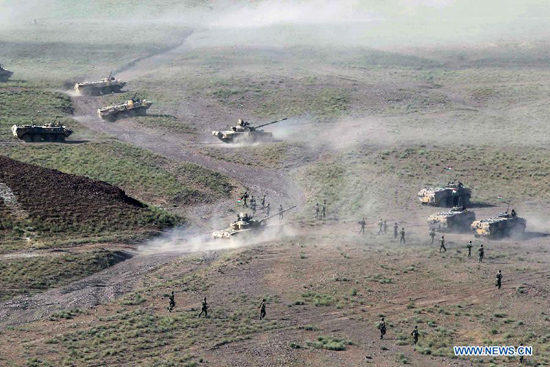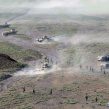
China Leads SCO Peace Mission 2012 in Central Asia
Publication: Eurasia Daily Monitor Volume: 9 Issue: 121
By:

The Shanghai Cooperation Organization (SCO) security agenda has been boosted in recent years through promoting multilateral counter-terrorist cooperation. One important feature in this counter-terrorist cooperation is the staging of Peace Mission joint military exercises ostensibly designed to test and strengthen the capability of the SCO to respond to terrorist threats among member states requiring some type of joint operation. Skeptics within the SCO, such as Uzbekistan, regard the model and scenario of the Peace Mission exercises to be inconsistent with the official claims concerning the anti-terrorist dimension. Others ask what the nature of a crisis might prove to be that would trigger joint action by the SCO. However, Peace Mission 2012 also revealed widely differing perspectives on the exercise in Moscow and Beijing, and the unmistakable message from China that it has effectively assumed a leadership role in the security dimension of the SCO (Interfax, Xinhua, June 18).
Peace Mission 2012 was held from June 8 to June 14 at the Chorukh-Dayron training range in northern Tajikistan. Around 2,000 personnel from China, Kazakhstan, Kyrgyzstan, Russia and Tajikistan participated in the exercises. Uzbekistan chose to avoid the event. Peace Mission 2012 was promoted by Moscow as aimed at testing “new methods” of blocking and destroying “illegal armed groups.” Russian forces involved in the exercise were drawn from ground attack aircraft at the Collective Security Treaty Organization (CSTO) Kant airbase in Kyrgyzstan, as well as a reinforced motorized rifle company from one of the battalions in the 201st Military Base in Tajikistan. Curiously, this battalion is also assigned to the CSTO’s Collective Rapid Reaction Forces (Kollektivnyye Sily Operativnogo Reagirovaniya – KSOR). In other words under cover of an SCO exercise Moscow was actually testing elements of its contribution to the KSOR and CSTO (Krasnaya Zvezda, June 18).
During Peace Mission 2012, the Russian reinforced motorized rifle company was deployed to the exercise area and carried out a 400-kilometer mounted road march, passing through two mountain passes: Anzob and Shakhristan. Ahead of this march, Russian and Tajikistani forces conducted reconnaissance of the planned route. The results of their findings were used to navigate the difficult mountain passes in the course of the exercise (Krasnaya Zvezda, June 18). It appears that the Russian top brass were not only interested in using Peace Mission 2012 to test force elements assigned to the CSTO and to the KSOR, but paid particular attention to how to insert forces into difficult mountainous terrain in Central Asia; some type of force projection was clearly being tested by Moscow, but the guise of the SCO seems misleading.
China’s Deputy Foreign Minister Cheng Guoping told the SCO Heads of State Council in Beijing on June 7 that the SCO will for the first time develop a “fully-fledged strategic development plan,” part of which relates to security. A number of factors, including the Arab Spring and the NATO withdrawal from Afghanistan, are serving to push the SCO’s level of political activity beyond its traditional focus. The SCO’s interests now transcend Central Asia and turn increasingly to issues of strategic stability including missile defense. During the Beijing SCO summit, the members’ foreign ministers included a missile defense clause in the final communique. Krasnaya Zvezda reported that the SCO is working on developing a common policy for members to pursue during a regional crisis. The SCO will develop a partnership network of international organizations involving the UN, CIS and CSTO (Krasnaya Zvezda, June 18).
Ci Guowei, the Deputy Director of the Foreign Affairs Office of the Chinese Ministry of National Defense, who was involved in planning and organizing the exercise, emphasized that the SCO will not become a “NATO of the East,” or fill a vacuum created in Central Asia post-2014. Guowei characterized in cautious terms the achievements of Peace Mission 2012, the smallest in the series of nine Peace Mission exercises since 2003. In his view “The joint military exercise is not a pure military action,” adding that its main aim was to build political trust and steadily increase the capability of the SCO to act as a security guarantor in Central Asia. All sides participating in the exercise had to face new challenges, based on introducing “innovative” approaches to combat operations. Guowei noted that, in addition to joint military exercises, the SCO had ensured regular meetings of members’ defense ministers, and extended this across inter-governmental departments and defense and security forums. For Guowei, the future development of the security dimension of the SCO will be gradual and continuous. “There is no best; just better,” he explained (Xinhua, June 14).
In an article in Renmin Ribao, Fang Zhenjun, a Beijing-based expert in international relations and military affairs, also dismissed the assertion that the SCO might compete with or promote a vision of being a NATO of the East. Zhenjun referred to the SCO’s “security concept,” which promotes mutual trust, benefit, consultation and respect for “diverse civilizations.” This approach was contrasted with NATO out-of-area operations, which had brought only mixed results in recent years, providing the examples of Kosovo, Afghanistan and Libya (Renmin Ribao, June 14).
Differences in approach to the SCO clearly exist between Moscow and Beijing, and Peace Mission 2012 again brought these distinctions to the fore. The former is keen to stress the military dimension, and the latter emphasizes the need for cooperation and non-interference in crisis situations. During Peace Mission 2010, the People’s Liberation Army (PLA) demonstrated network-centric capabilities lacking in the Russian Armed Forces, and chose to conduct a mid-air refueling of fighter aircraft during a rehearsal of precision strikes in southern Kazakhstan, despite the assets flying from bases in western China; Beijing evidently wanted to showcase strategic airpower capabilities and the fact that all hardware used in the exercise was domestically produced (Interfax, June 14-19).
According to observers of Peace Mission 2012, the PLA was not showcasing military equipment this year – unlike Kazakhstan, which displayed its newly-procured, Turkish Cobra armored personnel carriers – but Beijing’s message was in fact much deeper. Observers of the exercises told Jamestown that the forces they saw were quite clearly “China-led.” Despite official claims of deferring to the Tajikistani General Staff, or showing a parity of numbers of personnel between China and Russia, Peace Mission 2012 had a de facto leader: the PLA. This is the most salient feature of Peace Mission 2012; and China’s leadership of the SCO will likely shape its future security evolution and capabilities.




